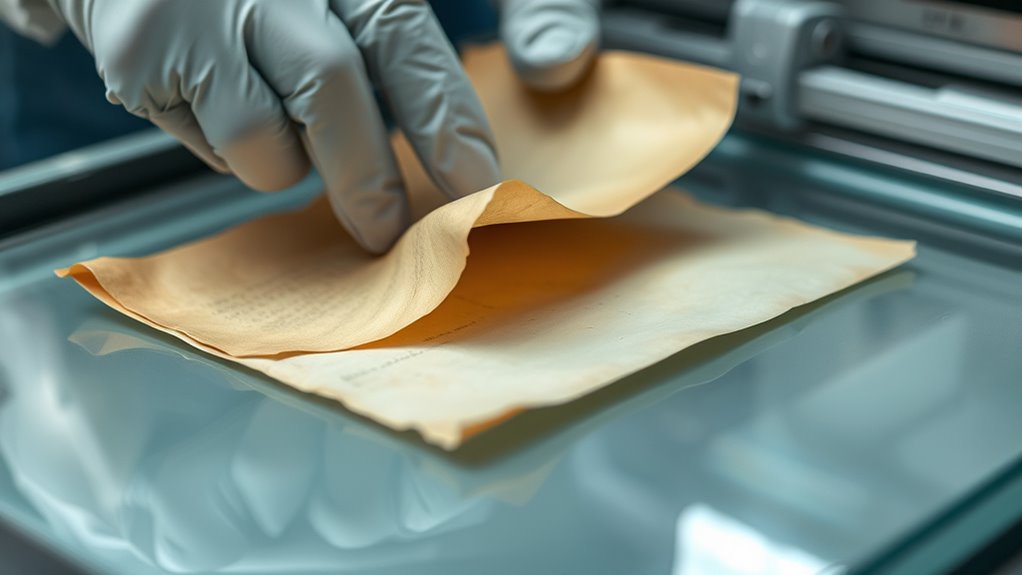When handling delicate paper for scanning, support the document with acid-free tissues and gently flatten any folds or curls. Wash your hands to avoid transferring oils and use protective transparent sheets on the scanner bed to reduce friction and prevent tears. Handle the paper carefully, avoiding any pressure or forced movements, and guarantee it’s properly aligned before scanning. For more tips on preserving fragile documents, keep exploring how to protect and care for your papers effectively.
Key Takeaways
- Wash hands thoroughly to prevent oils and dirt transfer onto fragile paper.
- Use protective, transparent sheets to buffer the document and prevent direct contact with the scanner glass.
- Gently flatten and support curled or crinkled paper before scanning to reduce stress and tears.
- Align the document flat on the scanner bed, avoiding creases or folds, and cover with protective sheets.
- Handle the paper carefully during removal, and store it in a cool, dry place to preserve its condition.

Scanning delicate paper requires careful handling to prevent tears, smudges, or other damage. When you’re working with fragile documents, your goal is to preserve their condition while capturing a clear, accurate digital copy. To do this effectively, you need to focus on restoring paper integrity as much as possible before scanning. One of the best ways to achieve this is by using protective sheets—thin, transparent layers that shield the paper from direct contact with the scanner glass. These sheets act as a buffer, reducing friction and preventing potential tears or smudges during the process. Before placing the document on the scanner, gently clean the glass surface to remove dust or fingerprints, which can cause imperfections in the scan.
Handle fragile documents gently and use protective sheets to prevent tears and damage during scanning.
When handling the paper itself, always wash your hands to avoid transferring oils or dirt that could weaken the fibers or stain the document. If the paper is extremely fragile, consider using acid-free tissue paper or archival-quality protective sheets to support the document during placement. Carefully align the paper on the scanner bed, making sure it’s flat and free of folds or creases. If the document is curled or rolled, gently flatten it with your hands or place it under a light weight wrapped in a protective sheet for a few moments. This minimizes the risk of further damage when you scan it.
Using protective sheets not only safeguards the paper but also helps in restoring its overall integrity. These sheets prevent direct contact with the scanner glass, reducing the chances of sticking or tearing. When you’re ready, position the protective sheet over the document, ensuring it covers the entire surface. This creates an even surface for the scanner to capture sharp, clear images without pressing too hard or causing stress to the fragile paper. Always scan on the lowest feasible resolution that still captures the necessary detail to avoid unnecessary strain on the document.
During the entire process, handle everything gently. Avoid forcing the paper or applying pressure that could cause tears. If you notice any crinkles or folds, adjust the protective sheet or flatten the document further before rescanning. After completing the scan, carefully remove the protective sheet and store the original document in a cool, dry place to further preserve its condition. Restoring paper integrity through careful handling and using protective sheets makes the entire scanning process safer for delicate papers and ensures you maintain their longevity for future reference. Additionally, selecting the appropriate resolution can help minimize stress on fragile documents, ensuring a high-quality scan without risking damage.
Frequently Asked Questions
Can I Scan Fragile Paper With a Standard Office Scanner?
You might wonder if a standard office scanner can handle fragile paper. While it’s possible, it’s not ideal, as you risk damage. Instead, use archival preservation and paper conservation techniques to protect delicate documents. Carefully support the paper, use a flatbed scanner with gentle settings, and avoid feeding fragile sheets through automatic feeders. This approach helps preserve your documents’ integrity while ensuring quality scans.
What Are the Signs of Damage After Scanning Delicate Paper?
After scanning delicate paper, you might notice signs of damage like paper discoloration or ink smudging. These issues indicate the paper has been affected by the process, especially if the paper is fragile or has sensitive ink. You should inspect your scanned documents carefully. If you see discoloration or smudging, it’s a sign that the paper might have been compromised during scanning, and you may need to handle the originals more carefully in the future.
How Do I Store Delicate Paper Post-Scanning?
Storing delicate paper is like placing a fragile butterfly in a glass case. You should keep it in archival storage, which protects it from light, dust, and environmental changes. Use acid-free envelopes to prevent deterioration and acid migration. Store the documents flat in a cool, dry place, away from direct sunlight. This careful approach guarantees your precious papers stay preserved and pristine for years to come.
Are There Specific Cleaning Tips for Delicate Paper Scanners?
You should follow gentle cleaning techniques to keep your delicate paper scanner in top shape. Use a soft, lint-free cloth and avoid harsh chemicals, opting for a slightly damp cloth instead. Incorporate regular maintenance routines, like dusting and inspecting rollers, to prevent buildup and damage. This proactive approach guarantees your scanner stays clean and functions smoothly, protecting your delicate paper and extending the device’s lifespan.
Is It Better to Digitize Fragile Documents Using a Professional Service?
Think of digitizing fragile documents like handling a delicate butterfly—you want to do it with utmost care. While a professional service uses archival quality preservation techniques to guarantee your documents stay intact, it’s often better for you to handle highly delicate papers yourself if you’re confident, to avoid potential damage. However, for irreplaceable or extremely fragile items, professional digitization ensures ideal preservation and quality.
Conclusion
So, next time you’re faced with fragile paper, remember—treat it like royalty, but don’t forget to handle it with the gentle touch of a bomb squad. Irony is, the more delicate it is, the more you’ll wish you’d been extra careful from the start. After all, risking a tear just for a quick scan isn’t worth the heartbreak. Handle with care, and your precious pages will thank you, even if they never say so.









